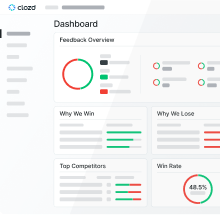As a Chief Revenue Officer, your focus is clear: sustainable, predictable revenue growth. While sales targets and pipeline health are critical, true, lasting revenue expansion hinges on something more fundamental: the customer experience. It's not just about closing deals; it's about nurturing the entire customer journey, from initial contact to long-term loyalty.
This is where customer feedback becomes your most powerful strategic asset. It's the unfiltered voice of your market, offering direct insights into what's working, what's not, and where the next opportunities for growth lie. For CROs, customer feedback isn't merely a customer service function; it's a data-driven lever to optimize customer experience (CX), reduce churn, and unlock new revenue streams.
In this guide, we'll explore why customer feedback is indispensable for CROs and provide actionable strategies to leverage it, ensuring your revenue engine is not just running, but thriving on a foundation of customer-centricity.
Why Customer Experience is a CRO's Top Priority
The role of a Chief Revenue Officer extends far beyond traditional sales leadership. You're tasked with a holistic view of all revenue-generating processes, ensuring seamless alignment across marketing, sales, and customer success. This integrated approach is essential because every touchpoint in the customer journey impacts your bottom line.
A superior customer experience isn't just a nice-to-have; it's a direct driver of revenue. Happy customers are more likely to purchase, stay longer, expand their engagement, and become powerful advocates for your brand. Conversely, a poor customer experience leads to frustration, churn, and lost revenue opportunities. Your ability to understand and act on customer needs directly influences your company's financial health.
The Direct Link Between CX and the Bottom Line
For CROs, the connection between customer experience and key performance indicators (KPIs) is undeniable. Consider these vital metrics:
- Customer Lifetime Value (CLV): When customers have a positive experience, they tend to stay with your company longer and spend more over time. This directly increases their CLV, a critical indicator of long-term revenue potential.
- Customer Acquisition Cost (CAC): While CX doesn't directly lower CAC, a strong reputation built on excellent customer experience can lead to more organic referrals and word-of-mouth marketing, indirectly reducing the reliance on expensive acquisition channels.
- Customer Retention Rates and Churn: High churn rates are a revenue killer. By improving CX based on feedback, you address the root causes of dissatisfaction, leading to higher retention rates and a more stable, predictable revenue base.
- Conversion Rates: A smooth, intuitive customer journey, informed by user feedback, can significantly improve conversion rates at every stage, from lead to closed deal.
- Upselling and Cross-selling: Satisfied customers are more open to exploring additional products or services. A positive experience builds trust, making it easier to expand the value of existing customer relationships.
By focusing on CX, CROs aren't just improving customer satisfaction; they are strategically impacting the core financial metrics that define success.
Breaking Down Silos: CX as a Cross-Functional Imperative
One of the CRO's primary responsibilities is to foster cross-functional alignment. The customer journey is rarely linear or confined to a single department. It spans marketing's initial outreach, sales' engagement, product's functionality, and customer success's ongoing support.
Customer feedback acts as the unifying thread, providing a shared understanding of customer needs and pain points across these teams. By leveraging this feedback, CROs can:
- Identify Friction Points: Pinpoint where customers encounter obstacles or dissatisfaction, whether it's in the sales process, onboarding, product usage, or support interactions.
- Align Goals: Ensure that marketing, sales, and customer success teams are all working towards a unified goal of enhancing the customer experience, rather than operating in isolation.
- Optimize Processes: Streamline workflows and remove inefficiencies that negatively impact the customer journey, leading to a more seamless and enjoyable experience.
This collaborative approach, driven by customer insights, is fundamental to creating a truly customer-centric organization that drives sustainable revenue growth.
Understanding Customer Feedback as a Strategic Asset
So, what exactly is customer experience feedback? Simply put, it's any information customers provide about their interactions with your company, products, or services. This feedback can be explicit, like survey responses, or implicit, like usage data or support ticket trends. For a CRO, this isn't just data; it's the unfiltered voice of your revenue stream.
Why is customer feedback important for CROs? Because it provides direct, actionable insights into the health of your customer relationships and the effectiveness of your revenue-generating processes. It helps you understand customer expectations, preferences, and pain points, allowing you to make data-driven decisions that directly impact conversion, retention, and overall revenue.
Types of Customer Feedback CROs Should Prioritize
To gain a comprehensive understanding, CROs should prioritize collecting both quantitative and qualitative feedback:
- Quantitative Feedback: This provides measurable data and trends.
- Net Promoter Score (NPS): Measures customer loyalty and willingness to recommend. A high NPS often correlates with higher CLV and lower churn.
- Customer Satisfaction (CSAT): Measures satisfaction with a specific interaction or overall experience.
- Customer Effort Score (CES): Measures how much effort a customer had to exert to resolve an issue or complete a task. Lower effort generally leads to higher satisfaction.
- Usage Analytics: Data on how customers interact with your product or website, revealing patterns and potential friction points.
- Qualitative Feedback: This provides rich, contextual insights into the "why" behind the numbers.
- Open-ended Survey Responses: Allows customers to express their thoughts in their own words.
- Customer Interviews and Focus Groups: Direct conversations that uncover deeper motivations, needs, and frustrations.
- Support Interactions: Transcripts, call recordings, and summaries from customer service interactions are a goldmine of real-time issues and common complaints.
- Social Media Monitoring and Reviews: Public sentiment and direct feedback on various platforms.
- Sales Team Feedback: Your frontline sales team often hears direct feedback from prospects and new customers about their initial experience and expectations.
By combining these types, you get a complete picture: the "what" (metrics) and the "why" (qualitative insights).
The Power of the Customer Feedback Loop
Collecting feedback is only half the battle. The true power lies in establishing a robust customer feedback loop. This involves a continuous process:
- Collect: Systematically gather feedback from various channels.
- Analyze: Synthesize the data to identify trends, common themes, and actionable insights.
- Act: Implement changes based on the insights, addressing pain points and capitalizing on opportunities.
- Communicate: Inform customers about the changes you've made based on their input. This step is crucial for building trust and showing that their voice matters.
A closed feedback loop demonstrates responsiveness and builds a customer-centric culture. When customers see their feedback leading to tangible improvements, it enhances their satisfaction, strengthens their loyalty, and ultimately contributes to higher customer retention rates. This continuous cycle of listening and improving is a cornerstone of quality improvement and a direct contributor to your revenue goals.
Actionable Strategies for CROs to Leverage Customer Feedback
Now, let's get into the practical strategies. As a CRO, your ability to translate customer feedback into actionable improvements across the entire customer journey is paramount for driving revenue growth.
Strategy 1: Pinpoint Friction Points Across the Customer Journey
One of the most effective ways to use consumer feedback to improve the customer experience is by identifying and eliminating friction points. Every obstacle a customer encounters, from their first interaction with your marketing to their ongoing use of your product, can lead to frustration and, ultimately, churn.
How to do it:
- Map the Customer Journey: Visually map out every stage of your customer's interaction with your company.
- Integrate Feedback at Each Touchpoint: Implement surveys (e.g., post-purchase, after a support interaction, in-app during key workflows) and analyze qualitative feedback (e.g., support tickets, sales call notes) specific to each stage.
- Look for Drop-offs and Negative Sentiment: Where do customers abandon a process? Where do CSAT scores dip? What common complaints appear in support logs?
- Example: If feedback consistently highlights confusion during the onboarding process, it's a clear signal to simplify documentation, improve tutorials, or offer more proactive support. This directly impacts early-stage retention and time-to-value, which are critical for long-term CLV.
Mapping Feedback to Each Stage of the Customer Lifecycle
To effectively pinpoint friction, consider feedback relevant to each phase:
- Awareness/Consideration: Website feedback, content engagement, demo request forms. Insights here can refine your marketing strategy and lead generation.
- Acquisition: Feedback on the sales process, clarity of proposals, contract terms. This helps optimize your sales funnel and improve conversion rates.
- Onboarding: Surveys after initial setup, product tour feedback, early support interactions. Crucial for ensuring customers quickly realize value and reduce early churn.
- Retention/Expansion: Regular NPS/CSAT surveys, product usage feedback, support interactions, renewal conversations. This feedback is vital for identifying at-risk customers and opportunities for upselling.
Strategy 2: Enhance Product and Service Offerings
How does customer feedback impact the user experience? Directly. Your product or service is at the heart of the customer experience. Feedback provides invaluable insights into usability, desired features, and areas for improvement. This directly helps customers by providing them with a product that truly meets their needs and solves their problems.
How to do it:
- Prioritize Feature Requests: Analyze common feature requests from surveys, support tickets, and sales conversations. Prioritize those that align with your strategic goals and have the highest potential impact on customer satisfaction and revenue.
- Address Usability Issues: User feedback often highlights confusing interfaces, broken workflows, or missing functionalities. Addressing these improves the user experience, making your product stickier.
- Conduct Beta Programs: Invite a segment of your customer base to test new features or products and provide structured feedback before a wider launch.
From Insight to Innovation: Driving Product-Led Growth
For CROs, product enhancements driven by customer feedback are a direct path to product-led growth. When your product inherently solves customer problems and provides an intuitive experience, it reduces sales friction and increases adoption.
- Revenue-Driven Prioritization: Don't just build features; build features that customers are willing to pay for, or that significantly reduce churn.
- Iterative Improvement: Use feedback to continuously refine your product, ensuring it remains competitive and aligned with evolving customer needs.
Strategy 3: Optimize Sales and Marketing Strategies
Customer feedback isn't just for post-sale improvements; it's a powerful tool for refining your entire acquisition funnel. By understanding why prospects choose you (or don't), you can optimize your marketing strategy and sales approach for better conversion.
How to do it:
- Refine Messaging: Analyze feedback on your marketing materials, website copy, and sales pitches. Are they clear? Do they resonate with customer needs? Do they address common objections?
- Improve Lead Quality: Use feedback from your sales team about lead quality. Are marketing-qualified leads truly sales-ready? What information do sales teams need earlier in the process?
- Tailor Sales Pitches: Understand common customer pain points and desired outcomes from feedback. Equip your sales team with insights to personalize pitches and highlight the most relevant value propositions.
- Analyze Lost Deals: Conduct win/loss analysis, gathering feedback from prospects who chose a competitor. This provides critical insights into competitive advantages and areas where your offering or sales process falls short.
Refining the Acquisition Funnel with Customer Insights
By integrating feedback into your sales and marketing, you create a more efficient and effective acquisition engine:
- Targeted Campaigns: Use insights into customer preferences to create more relevant and impactful marketing campaigns.
- Shorter Sales Cycles: When sales teams are armed with a deep understanding of customer needs, they can address concerns proactively and accelerate the sales process.
- Higher Conversion Rates: A more aligned and customer-centric sales and marketing approach naturally leads to better conversion.
Strategy 4: Improve Customer Support and Service Quality
How can feedback from customer support interactions be used to improve service quality? Support interactions are a treasure trove of real-time customer pain points. Analyzing this feedback is crucial for improving service quality, which in turn boosts customer satisfaction and retention.
How to do it:
- Analyze Support Tickets: Categorize common issues, identify recurring problems, and track resolution times. This helps pinpoint systemic issues in your product or processes.
- Monitor CSAT Scores for Support Interactions: Immediately after a support interaction, ask for feedback. Low scores indicate a need for agent training, process changes, or better self-service options.
- Review Call Recordings/Transcripts: Listen to customer calls to understand the emotional context, identify communication gaps, and assess agent performance.
- Empower Frontline Teams: Provide support agents with the tools and authority to resolve issues efficiently. Their direct experience with customer problems is invaluable.
Transforming Support into a Revenue Driver
For CROs, excellent customer support isn't just a cost center; it's a revenue driver.
- Reduced Churn: Prompt and effective issue resolution prevents customers from becoming frustrated and leaving.
- Increased Loyalty: Customers remember positive support experiences, which strengthens their loyalty and willingness to recommend.
- Upsell Opportunities: A positive support interaction can sometimes open the door for an upsell or cross-sell conversation, especially if the issue was related to a feature they weren't fully utilizing.
- Product Insights: Support teams are often the first to hear about product bugs or usability issues, providing critical feedback for product development.
Strategy 5: Boost Customer Retention and Loyalty
How customer feedback helps to improve customer retention is by allowing you to proactively address issues, personalize experiences, and build stronger relationships. Why is customer feedback crucial in improving customer satisfaction? Because it shows customers you're listening and value their input, which directly translates to higher satisfaction and loyalty.
How to do it:
- Proactive Outreach Based on Sentiment: Use NPS or CSAT scores to identify at-risk customers (detractors) and reach out to them proactively to understand and address their concerns before they churn.
- Address Negative Feedback Promptly: A swift and empathetic response to negative feedback can turn a dissatisfied customer into a loyal advocate. It demonstrates that you care and are committed to resolving issues.
- Personalize Experiences: Use feedback on customer preferences and usage patterns to tailor communications, product recommendations, and support.
- Build a Customer-Centric Culture: Ensure that every team understands their role in the customer journey and is empowered to act on feedback.
Cultivating Long-Term Relationships for Predictable Revenue
High customer retention is the bedrock of predictable revenue. By leveraging feedback to foster loyalty, CROs can:
- Reduce Churn: Directly impact your churn rate by identifying and resolving the root causes of customer dissatisfaction.
- Increase Referrals: Satisfied, loyal customers are your best advocates, generating valuable word-of-mouth referrals that reduce CAC.
- Expand Account Value: Loyal customers are more likely to renew, upgrade, and purchase additional products or services, increasing CLV.
Strategy 6: Drive Data-Driven Decision Making
What role does customer feedback play in quality improvement? It provides the essential data points needed to identify areas for improvement, measure the impact of changes, and make informed strategic decisions. For CROs, integrating feedback data with other business metrics is key to truly data-driven revenue growth.
How to do it:
- Integrate Feedback Data: Connect your feedback platform with your CRM, sales data, product usage analytics, and financial systems. This allows for a holistic view of the customer and their impact on revenue.
- Identify Trends and Correlations: Look for patterns. Do customers with low NPS scores also have lower CLV? Does a specific product feature correlate with higher retention?
- Create Dashboards: Develop dashboards that combine CX metrics (NPS, CSAT) with revenue metrics (churn, CLV, conversion rates). This provides a clear picture of the impact of CX initiatives.
- Forecast Revenue with VoC Data: Use insights from customer feedback (e.g., sentiment analysis, identified pain points) to refine your revenue forecasts and identify potential risks or opportunities.
The CRO's Dashboard: Integrating Feedback with Core KPIs
A CRO's success hinges on their ability to make strategic decisions based on comprehensive data. Customer feedback, when properly integrated, becomes a powerful component of this data ecosystem.
- Connect CX to Financial Outcomes: Clearly link improvements in NPS or CSAT to tangible increases in CLV or reductions in churn.
- Identify Revenue Opportunities: Feedback can highlight unmet customer needs, signaling opportunities for new product development or market expansion.
- Optimize Resource Allocation: Data-driven insights from feedback can help you prioritize where to invest resources for the greatest impact on CX and revenue.
By treating customer feedback as a critical data stream, CROs can move beyond intuition and make truly informed decisions that drive sustainable revenue growth.
Building a Customer Feedback System for CRO Success
To effectively implement these strategies, CROs need a robust system for collecting, analyzing, and acting on customer feedback. This isn't just about having a survey tool; it's about creating an integrated, cross-functional approach.
Choosing the Right Tools and Channels
The right tools facilitate efficient feedback collection and analysis:
- Survey Platforms: For NPS, CSAT, CES, and open-ended surveys (e.g., in-app, email, website pop-ups).
- Customer Interview Software: For conducting and recording qualitative interviews.
- Social Media Listening Tools: To monitor brand mentions and public sentiment.
- CRM Integration: Essential for linking feedback directly to customer records and sales data.
- Dedicated Feedback Platforms: Solutions that centralize feedback from various channels, allowing for advanced analytics, sentiment analysis, and easy sharing across teams. These platforms can help you pinpoint key insights from large volumes of data.
Consider real-time feedback mechanisms, such as post-interaction surveys or in-app product feedback prompts, to capture insights at the moment of experience.
Establishing a Cross-Functional Feedback Loop
A successful feedback system requires clear ownership and collaboration across departments:
- Define Roles and Responsibilities: Who is responsible for collecting specific types of feedback? Who analyzes it? Who owns the action plan for different types of issues (e.g., product team for feature requests, sales for process improvements, customer success for retention)?
- Regular Feedback Review Meetings: Schedule recurring meetings with key stakeholders from marketing, sales, product, and customer success to review feedback, discuss insights, and assign actionable tasks.
- Communicate Changes Back to Customers: Close the loop by informing customers about how their feedback led to improvements. This can be done through in-app messages, email newsletters, or direct follow-up. This step is vital for building trust and demonstrating your commitment to their experience.
- Align Incentives: Ensure that team goals and compensation plans are aligned with customer satisfaction and retention metrics, reinforcing the importance of CX across the organization.
Measuring the Impact of Feedback-Driven Improvements
As a CRO, you need to see the return on investment (ROI) of your CX initiatives. Measuring the impact of feedback-driven improvements is crucial:
- Track Key Metrics Over Time: Monitor changes in NPS, CSAT, churn rate, CLV, conversion rates, and sales cycle length after implementing changes based on feedback.
- A/B Testing: For specific changes (e.g., website flow, onboarding process), use A/B testing to quantify the impact of the improvement on conversion or other revenue metrics.
- Customer Segmentation: Analyze feedback and its impact across different customer segments to identify specific needs and tailor strategies.
- Qualitative Success Stories: Collect testimonials and case studies from customers who have benefited from improvements driven by their feedback. These stories can be powerful internal motivators and external marketing assets.
By rigorously measuring the impact, you can demonstrate the tangible value of customer feedback to your executive team and stakeholders, reinforcing its strategic importance.
The Future of Revenue Growth is Customer-Centric
For Chief Revenue Officers, the path to sustainable, predictable revenue growth is inextricably linked to the customer experience. Customer feedback is not just a data point; it's the compass guiding your strategic decisions, illuminating opportunities to optimize every stage of the customer journey.
By embracing a customer-centric approach, leveraging diverse feedback channels, and establishing robust, cross-functional feedback loops, you can:
- Pinpoint and eliminate friction points that hinder conversions and drive churn.
- Innovate your product and service offerings to truly meet customer needs.
- Refine your sales and marketing strategies for more effective acquisition.
- Transform customer support into a powerful retention and advocacy engine.
- Drive truly data-driven decisions that directly impact your bottom line.
The companies that will dominate the market are those that listen intently to their customers and act decisively on their insights. As a CRO, your leadership in championing customer feedback will not only enhance customer experience but will also be the ultimate competitive advantage, ensuring your company's long-term revenue success.











.svg)






.jpg)




.svg)

.svg)




